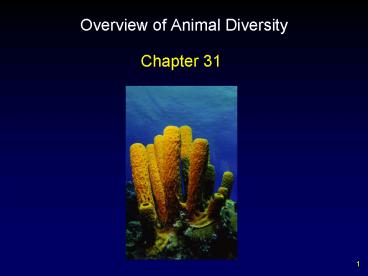Overview of Animal Diversity PowerPoint PPT Presentation
1 / 23
Title: Overview of Animal Diversity
1
Overview of Animal Diversity
- Chapter 31
2
General Features of Animals
- Heterotrophs
- Multicellular
- Able to move from place to place
- Diverse in form and habitat
- Sexual reproduction
- Characteristic embryonic development
3
Diverse Kingdom
- Traditional classification of animals
- multicellular animals, metazoans, traditionally
divided into 35 distinct phyla - First branch - tissues
- Parazoa lack definite symmetry and do not possess
tissues or organs. - Eumetazoa have definite shape and symmetry and
usually have organs and organ systems.
4
(No Transcript)
5
Traditional Classification of Animals
- Second branch - symmetry
- Eumetazoan branch has two principles branches.
- Radiata - radial symmetry
- Bilateria - bilateral symmetry
- Further branches were assigned by comparing key
shared features of the body plan. - body cavity
- coelom
6
Broad Groupings of Kingdom Animalia
7
Key Transitions in Body Plan
- Evolution of tissues
- first key transition in animal body plan
- Evolution of bilateral symmetry
- radial symmetry - regular arrangement of parts
around central axis - bilateral symmetry - right and left halves form
mirror images - dorsal vs. ventral
- anterior vs. posterior
8
Radial and Bilateral Symmetry
9
Bilateral Symmetry
- Bilaterally symmetrical eumetazoans produce three
germ layers. - ectoderm
- endoderm
- mesoderm
- Much of the nervous system is in the form of
major longitudinal nerve cords. - ultimately led to evolution of definite head
- cephalization
10
Key Transitions in Body Plan
- Evolution of a body cavity
- Presence of a body cavity allows digestive tract
to be larger and longer. - storage of undigested food
- more complete digestion
11
Key Transitions in Body Plan
- Kinds of body cavities
- acoelomates - no body cavity
- pseudocoelomates - possess pseudocoel
- coelomates - possess coelom
12
Three Body Plans
13
Coelomates
- Coelom poses circulation problem
- solved by circulatory system
- open circulatory system
- Blood passes from vessels into sinuses, mixes
with body fluid, and reenters vessels in another
location. - closed circulatory system
- Blood is physically separated from other body
fluids and can be separately controlled.
14
(No Transcript)
15
Key Transitions in Body Plan
- Evolution of deuterostome development
- mitotic egg division leads to blastula
- indents to form blastopore, opening to the
archenteron - Bilaterians can be divided into protostomes
(mouth-first) and deuterstomes (mouth-second).
16
Protostome and Deuterostome Differences
- Cleavage
- spiral
- radial
- Fate of embryonic cells
- determinate - predetermined fate
- indeterminate - identical daughter cells
- Fate of blastopore
- mouth or anus develops near blastopore
- Formation of coelom
17
Embryonic Development
18
(No Transcript)
19
(No Transcript)
20
(No Transcript)
21
Animal Classification is Being Reevaluated
- New look at metazoan family tree
- New taxonomical comparisons using molecular data
have come to new, different conclusions. - Molecular systematics uses unique sequences
within certain genes to identify clusters of
related groups.
22
Summary
- General Features of Animals
- Traditional Classification of Animals
- Key Transitions in Body Plan
- New Look at Metazoan Family Tree
23
(No Transcript)

